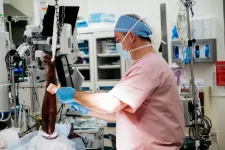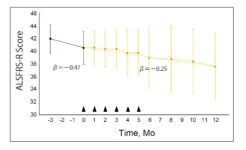(Press-News.org) A large multicenter clinical trial co-led by University of Maryland School of Medicine researchers large multicenter clinical trial co-led by University of Maryland School of Medicine researchers found that an antiseptic containing iodine resulted in about one-quarter fewer post-surgical infections in patients with limb fractures compared to another frequently used skin antiseptic. The results of the study of nearly 8,500 patients across the United States and Canada were published today in the New England Journal of Medicine.
The study – which compared the two most commonly used alcohol-based solutions, one with iodine povacrylex, and the other with chlorhexidine gluconate – may prompt changes in the type of antiseptic orthopaedic surgeons use to prepare the skin to repair fractures. Researchers saw the benefit in patients with closed, or simple fractures, where the skin remains intact, but not in compound fractures with open wounds, although they noted that using the iodine preparation was not harmful to these open-fracture patients.
“Our results suggest that the use of iodine povacrylex in alcohol as a preoperative skin antiseptic could prevent surgical-site infections in thousands of patients with closed fractures each year,” said co-principal investigator Gerard Slobogean, MD, MPH, an Associate Professor of Orthopaedics and Director of Clinical Research in the Department of Orthopaedics at the University of Maryland School of Medicine (UMSOM). He is also an orthopaedic trauma surgeon at the R Adams Cowley Shock Trauma Center at the University of Maryland Medical Center (UMMC).
Each year, more than a million Americans suffer a broken bone in the arm, leg, or pelvis that requires surgery, and about 3 percent of these patients develop a surgical-site infection. The source of bacteria could be the patient’s skin, the injury environment, or from the hospital. Although some guidelines have favored using chlorhexidine gluconate over other iodine products, there has not been a consensus on the most effective agent.
Dr. Slobogean and his colleagues believe that the trial, which included 8,485 patients treated at 25 trauma centers, is the largest randomized clinical trial ever conducted to compare the two antiseptics, which allowed them to detect important differences in infection. They said that the findings may also be relevant to other surgical specialties.
More than 6,700 patients who had surgery to treat a closed lower extremity or pelvic fracture and 1,700 patients who had surgery to treat an open fracture participated in the study.
The R Adams Cowley Shock Trauma Center and University of Maryland Capital Region Health’s (UM Capital) trauma center in Largo, Md., were among more than two dozen trauma centers to enroll patients. UMMC and UM Capital are part of the 11-hospital University of Maryland Medical System (UMMS).
“The results of this well-designed study provide some long overdue clarity to orthopaedic trauma surgeons with respect to which commonly used antiseptic skin preparation is more effective when preparing for fracture surgery,” said study co-author Todd Jaeblon, DO, an Associate Professor of Orthopaedics at UMSOM who treats patients at UM Capital.
Of the 3,205 closed-fracture patients who received 0.7% iodine povacrylex in 74% isopropyl alcohol, 77, or 2.4 percent, developed a surgical-site infection. That compares with 108, or 3.3 percent of the 3,272 patients who received 2% chlorhexidine gluconate in 70% isopropyl alcohol. In patients with open fractures, the number of patients who developed infections was similar between the two antiseptics – 54 patients, or 6.5 percent of 825 patients in the iodine group, and 60 patients, or 7.3% of the 826 patients in the chlorhexidine group.
“Extremity fractures and the challenging surgical-site infections that result from them pose a significant health care burden on our nation,” said Mark T. Gladwin, MD, who is the John Z. and Akiko K. Bowers Distinguished Professor and Dean, UMSOM, and Vice President for Medical Affairs, University of Maryland, Baltimore. “This pragmatic trial tested two widely used antiseptics, and its crossover design minimized selection bias. It also enrolled patients from 25 diverse hospitals in the U.S. and Canada, which improved the generalizability of the results; the strength of the study design could serve as a model for other researchers.”
The PREPARE (Pragmatic Randomized Trial Evaluating Preoperative Alcohol Skin Solutions in Fractured Extremities) trial was jointly led by UMSOM and McMaster University of Hamilton, Ontario. It was funded with $11.2 million from the Patient-Centered Outcomes Research Institute (PCORI), with additional support from the Canadian Institutes of Health Research.
“This trial represents a highly successful collaboration between McMaster University, the University of Maryland School of Medicine, and 25 trauma centers across Canada and the United States,” said co-principal investigator Sheila Sprague, PhD, an Associate Professor and Research Director at McMaster University. “This multidisciplinary approach allowed us to quickly and efficiently address an important clinical research question that will lead to the prevention of thousands of infections each year. Importantly, our collaborations will continue to grow to address other unanswered questions in orthopaedic trauma surgery.”
This is the second clinical study co-led by Dr. Slobogean and Dr. Sprague aimed at closing the gaps in the medical literature on the most effective infection-control techniques in orthopaedic surgery. In October 2022, they published the results of the Aqueous-PREP trial in The Lancet. They concluded that the choice of an aqueous antiseptic solution – either 10% povidone-iodine or 4% chlorhexidine gluconate – does not alter the risk of surgical-site infection for patients with an open fracture.
Both Aqueous-PREP and PREPARE follow a master protocol called PREP-IT (Program of Randomized Trials to Evaluate Preoperative Antiseptic Skin Solutions in Orthopaedic Trauma) to test infection prevention techniques in trials that will provide crucial evidence to help guide surgical practices.
This research was supported by the PREP-IT investigators, which includes a network of over 200 physicians, allied health care professionals, trauma patients, and clinical researchers.
About the R Adams Cowley Shock Trauma Center
The R Adams Cowley Shock Trauma Center, University of Maryland was the first fully integrated trauma center in the world and remains at the epicenter for trauma research, patient care, and teaching, both nationally and internationally today. Shock Trauma is where the "golden hour" concept of trauma was born and where many lifesaving practices in modern trauma medicine were pioneered. Shock Trauma is also at the heart of the Maryland's unparalleled Emergency Medical Service System. Learn more about Shock Trauma.
About the University of Maryland School of Medicine
Now in its third century, the University of Maryland School of Medicine was chartered in 1807 as the first public medical school in the United States. It continues today as one of the fastest growing, top-tier biomedical research enterprises in the world -- with 46 academic departments, centers, institutes, and programs, and a faculty of more than 3,000 physicians, scientists, and allied health professionals, including members of the National Academy of Medicine and the National Academy of Sciences, and a distinguished two-time winner of the Albert E. Lasker Award in Medical Research. With an operating budget of more than $1.3 billion, the School of Medicine works closely in partnership with the University of Maryland Medical Center and Medical System to provide research-intensive, academic, and clinically based care for nearly 2 million patients each year. The School of Medicine has nearly $600 million in extramural funding, with most of its academic departments highly ranked among all medical schools in the nation in research funding. As one of the seven professional schools that make up the University of Maryland, Baltimore campus, the School of Medicine has a total population of nearly 9,000 faculty and staff, including 2,500 students, trainees, residents, and fellows. The combined School of Medicine and Medical System (“University of Maryland Medicine”) has an annual budget of over $6 billion and an economic impact of nearly $20 billion on the state and local community. The School of Medicine, which ranks as the 8th highest among public medical schools in research productivity (according to the Association of American Medical Colleges profile) is an innovator in translational medicine, with 606 active patents and 52 start-up companies. In the latest U.S. News & World Report ranking of the Best Medical Schools, published in 2021, the UM School of Medicine is ranked #9 among the 92 public medical schools in the U.S., and in the top 15 percent (#27) of all 192 public and private U.S. medical schools. The School of Medicine works locally, nationally, and globally, with research and treatment facilities in 36 countries around the world. Visit medschool.umaryland.edu
About the University of Maryland Medical Center
The University of Maryland Medical Center (UMMC) is comprised of two hospital campuses in Baltimore: the 800-bed flagship institution of the 11-hospital University of Maryland Medical System (UMMS) and the 200-bed UMMC Midtown Campus. Both campuses are academic medical centers for training physicians and health professionals and for pursuing research and innovation to improve health. UMMC's downtown campus is a national and regional referral center for trauma, cancer care, neurosciences, advanced cardiovascular care, and women's and children's health, and has one of the largest solid organ transplant programs in the country. All physicians on staff at the downtown campus are clinical faculty physicians of the University of Maryland School of Medicine. The UMMC Midtown Campus medical staff is predominately faculty physicians specializing in a wide spectrum of medical and surgical subspecialties, primary care for adults and children and behavioral health. UMMC Midtown has been a teaching hospital for 140 years and is located one mile away from the downtown campus. For more information, visit www.umm.edu.
END
Large multicenter clinical trial finds that antiseptic containing iodine reduces surgical-site infections in patients with extremity fractures
Study results published in the New England Journal of Medicine could prevent thousands of surgical-site infections each year, researchers predict
2024-02-01
ELSE PRESS RELEASES FROM THIS DATE:
Jealousy – we understand our own sex best
2024-02-01
We may not always fully understand why our partners get jealous, and women and men often get jealous for completely different reasons.
Two researchers from the Norwegian University of Science and Technology (NTNU) decided to investigate whether people also know about these distinct differences between the sexes.
“What do people think triggers women’s and men’s jealousy? How well do women understand men’s jealousy, and men women’s jealousy? We wanted to find out,” says Professor Mons Bendixen at the Department of Psychology.
Men are more jealous ...
Hiring the most qualified candidate might be unfair
2024-02-01
WASHINGTON — Both liberals and conservatives are more likely to believe that merit-based hiring is unfair after learning about the impacts of socioeconomic disparities, according to a study published by the American Psychological Association.
People from across the political spectrum also are more likely to support programs that encourage socioeconomic diversity after learning about the effects of social class and low income, according to the research, published online in the Journal of Experimental Psychology: General.
“Socioeconomic disadvantages early in life can undermine educational achievement, ...
Excavation of colossal caverns for Fermilab’s DUNE experiment completed
2024-02-01
Excavation workers have finished carving out the future home of the gigantic particle detectors for the international Deep Underground Neutrino Experiment. Located a mile below the surface, the three colossal caverns are at the core of a new research facility that spans an underground area about the size of eight soccer fields.
Hosted by the U.S. Department of Energy’s Fermi National Accelerator Laboratory, DUNE scientists will study the behavior of mysterious particles known as neutrinos to solve some of the biggest questions about our universe. Why is our ...
BIPOC individuals bear greater post-COVID health burdens, new research suggests
2024-02-01
Black, indigenous, and people of color (BIPOC) who were infected with COVID-19 experienced greater negative aftereffects in health and work loss than did similarly infected white participants, new research finds.
Despite similar symptom prevalence, BIPOC and Hispanic patients experienced greater negative impacts on their health status, activity levels, and ability to work compared with non-Hispanic and white patients participating in the ongoing multi-site INSPIRE clinical trial examining people with long COVID.
The findings are published in the journal Frontiers ...
National Academy of Medicine member new president of The Obesity Society
2024-02-01
ROCKVILLE, Md. — A member of the National Academy of Medicine is the new president of The Obesity Society (TOS), the organization announced today.
Jamy Ard, MD, FTOS, is professor in the Departments of Epidemiology and Prevention and Internal Medicine and vice dean of Clinical Research at Wake Forest University School of Medicine in Winston-Salem, N.C. He also co-directs the Atrium Health Wake Forest Baptist Weight Management Center, where he oversees medical weight management programs.
“I am honored to serve as president of ...
How to run a password update campaign efficiently and with minimal IT costs
2024-02-01
Updating passwords for all users of a company or institution’s internal computer systems is stressful and disruptive to both users and IT professionals. Many studies have looked at user struggles and password best practices. But very little research has been done to determine how a password update campaign can be conducted most efficiently and with minimal IT costs. Until now.
A team of computer scientists at the University of California San Diego partnered with the campus’ Information Technology Services to analyze the messaging for a campuswide mandatory ...
Five advances that could change heart health monitoring
2024-02-01
Chocolate valentines and candies with sweet sayings shouldn't be the only hearts you think about this February. It’s also American Heart Month, which puts a spotlight on cardiovascular health. According to the American Heart Association, heart disease is the leading cause of death for Americans, so it’s important to know the status of your own heart health. New methods for cardiac monitoring can be found in these five papers recently published in ACS journals. Reporters can request free access to these papers by emailing newsroom@acs.org.
Future ...
Gut bacteria can process dietary fiber into an anti-allergy weapon, finds new study
2024-02-01
The intricate relationship that exists between humans and the gut microbiome has become a hot research topic, and scientists are constantly uncovering new reasons why a healthy diet can lead to a healthier life. Dietary fibers are a particularly important aspect of this connection. When we ingest these compounds, which are mainly found in plant-based foods, our gut bacteria break them down into small molecules, called short-chain fatty acids (SCFAs). Over the past few years, studies have revealed various important anti-inflammatory and immunomodulating effects of SCFAs.
One of the ways SCFAs interact with ...
Insights from a phase II clinical trial with CL2020 Muse cell-based therapeutic for Amyotrophic lateral sclerosis
2024-02-01
Amyotrophic lateral sclerosis (ALS) is a neurodegenerative disease characterized by progressive loss of motor functions, which eventually leads to death within 5 years of its onset. This disease causes weakness and atrophy of limbs and other muscles, which affect mobility speech, eating, and even breathing in patients. Some drugs, including riluzole, edaravone, and sodium phenylbutyrate/taurursodiol are used for treating ALS, but with limited therapeutic benefits. Therefore, novel, effective ALS treatments are the need of the hour.
Multilineage-differentiating stress-enduring (Muse) cells are pluripotent stem cells ...
Increased temperature difference between day and night can affect all life on earth
2024-02-01
Researchers from Chalmers University of Technology, in Sweden, have discovered a change in what scientists already knew about global warming dynamics. It had been widely accepted since the 1950s that global temperature rises were not consistent throughout the day and night, with greater nighttime warming being observed. However, the recent study reveals a shift in dynamics: with greater daytime warming taking place since the 1990s. This shift means that the temperature difference between day and night is widening, potentially affecting all life on Earth.
The ...
LAST 30 PRESS RELEASES:
School meals could unlock major gains for human and planetary health
Menopause hormone therapy does not appear to impact dementia risk
Signature patterns of brain activity may help predict recovery from traumatic brain injury
Dresden study uncovers new key mechanism in cancer cells
New species are now being discovered faster than ever before, study suggests
Cannabis-based products show limited short-term benefit for chronic pain, with increased risk of adverse effects
Cannabis products with more THC slightly reduce pain but cause more side effects
Clearing the brain of aging cells could aid epilepsy and reduce seizures
Brain injuries linked with potential risk of suicide, new study finds
New technique lights up where drugs go in the body, cell by cell
New study finds movement of fishing fleets can reveal shifts in marine ecosystems
Embargoed: New evidence points to potential treatment for vascular dementia
Study uncovers disrupted brain balance in alcohol dependence
Working in groups can help Republicans and Democrats agree on controversial content moderation online
Structural findings reveal how distinct GPCR ligands create different levels of activation
Anything-goes “anyons” may be at the root of surprising quantum experiments
UC review: Maximizing workplace opportunity for veterans
From generation to complex control: Metasurfaces make perfect vortex beams "within reach"
Thin-film lithium niobate-based detector: recent advances and perspectives
Exploring why some people may tend to persistently make bad choices
How cells balance their protein levels
Nirsevimab vs RSVpreF vaccine for RSV–related hospitalization in newborns
Effectiveness and impact of maternal RSV immunization and nirsevimab on medically attended RSV in US children
AI gives scientists a boost, but at the cost of too many mediocre papers
Next-generation vision model maps tree growth at sub-meter precision
Genes aren’t destiny for inherited blindness, study shows
MIT study: High-fat diets make liver cells more likely to become cancerous
Exposure to multiple fine particulate matter components and incident depression in the US Medicare population
Risk of burdensome health care spending over time in the US
Nirsevimab against hospitalizations and emergency department visits for lower respiratory tract infection in infants
[Press-News.org] Large multicenter clinical trial finds that antiseptic containing iodine reduces surgical-site infections in patients with extremity fracturesStudy results published in the New England Journal of Medicine could prevent thousands of surgical-site infections each year, researchers predict






